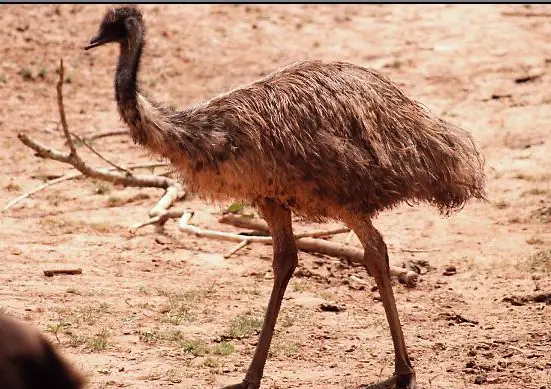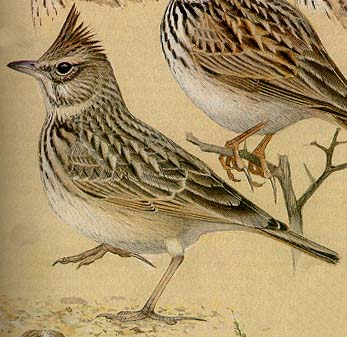Emu
The Emu is Australia’s tallest native bird and will reach a height of 3 to 5 feet when standing upright. It may also reach weights of 60 to 70 pounds and is a bit lighter than the cassowary, which is a distant cousin. They have very shaggy feathers which are colored a grayish brown and the neck and head are usually bald and colored a deep blue-black.
They have legs which are very long and powerful, but wings that are quite small resulting in their flightless state. They are set aside from most of the heavier birds by the fact that they have no toe in the back of their foot, only the three toes that face forward.The name Emu itself is aboriginal and sources indicate that it may have derived from an Arabic word meaning simply “large bird”.

A young emu hunts for breakfast
The Emu is found exclusively in Australia, but ranges throughout most of the continent with the exception of the rain forest in which the can rarely be found and the very arid sections. These flightless birds were once also found in Tasmania, but were believed to be eradicated soon after the first European settlers landed. There were two species of dwarf Emus that
lived on Kangaroo island and King Island, but these have long since become extinct. You will not find Emus in the more
populated regions however despite this in the more rural areas they have increased dramatically in number. This is largely attributed to the ability of the Emu to reproduce at a very rapid rate and the fact that the availability of water that is put out for livestock has helped them survive in what is a very harsh climate.
Emus will eat fruits, seeds, the growing shoots of plants, insects, other small animals and even animal droppings. They will
relocate according to conditions, each has a specific territory which they will remain in as long as food and water are adequate, but if conditions become less than desirable they move to a new location. They may move hundreds of kilometers in search of suitable habitat in times of hardship.
The nesting takes place in the winter months and the male and female remain a pair for around 4 to 5 months during which the courtship and actual mating take place. The mating call of the male may consist of grunting, booming, and drumming which can often be heard for 1 to 2 kilometers. The pair will stay together during the entire process of building the nest and the laying of eggs. The nest is usually a grass platform on the ground that would measure about 2 to 4 feet in diameter.
During the mating process the female is the dominant one, however after the eggs are layed the male becomes quite hostile towards other birds including the female and eventually the female will leave and the incubation is left solely up to the father. During this time the father will not leave the nest for any reason, not to drink eat or even defecate and if an egg rolls out of the nest, it will immediately be pulled back in by the father.
After the incubation period, the chicks will hatch and are a light cream color with darker brown stripes and will stay in the nest for 7 to 10 days during which the father will provide food. After this period, they will leave the nest under the protective eye of their father and will remain with him for 4 to 6 months until they are able to care for themselves. After they reach around 6 months of age, the fluffy white chick feathers will give way to the typical shaggy brown plumage of the adult.




this site needs to have more information about emu birds and other things for kids to look up about such as are emu birds mammals and other things like that
COOL
i find most of the wildlife i am looking for on this sight but i
must admit you dont give out much information i have ausytralian
citizenship so found out most things for myself but some times
if looking for somethings you dont get the name and a lot of
silly blogs some times more blogs then the images you are looking for
i like to look for wild life and if possible do some research on it
molongsheila@aol.com
so the emu is an ostrish i think that was like mmmmm colibris meybe
HAHA COOL BIRD